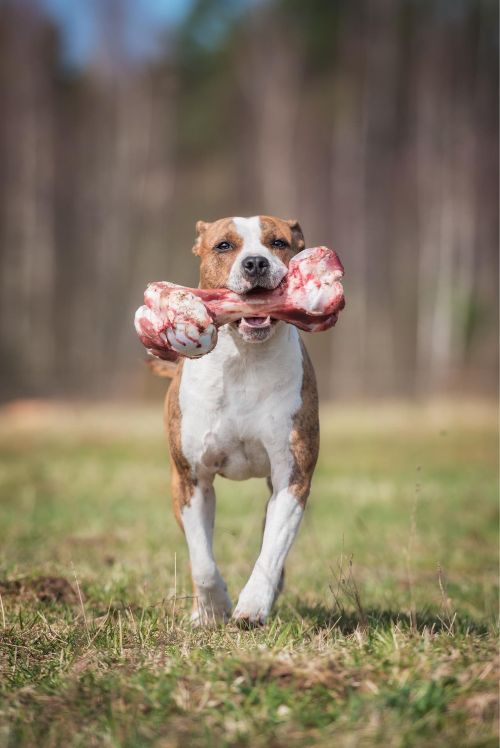How to Use Dog Bones Safely in Westchester County, NY
August 11, 2022
Bones are famously associated with dogs, but they can present serious health and safety issues when used incorrectly. Before you throw your dog a bone, here are a few tips on how to use dog bones safely.

Benefits of Dog Bones
Although chewing bones has potential risks, it offers many physical, mental, and nutritional benefits.
- Curb Chewing: Bones provide dogs with enough jaw bone stimulation to help curb their natural desire to chew. This is especially great for pups who inflict their chewing habits on innocent items around the house. For puppies, chewing bones helps to alleviate teething pain. Rather than turning to chew on the furniture or shoes to ease the discomfort, bones can give your puppy a better way to relieve their teething pain.
- Improve Dental Health: Dog bones can help to improve your dog's dental health. Chewing bones shouldn't replace regular brushing or vet visits. But chewing bones occasionally can help prevent plaque buildup, keep gums healthy, and remove tartar and bacteria from the teeth.
- Mental Stimulation: Bones help to keep your dog mentally energized. They act as a tasty way to counteract boredom. They can also double as a coping mechanism for dogs who experience stress or anxiety.
Bones to Avoid
Giving your dog the wrong kind of bone can be extremely hazardous. If you’re considering giving your dog a bone, stay away from these options:
- Small Bones: Small bones pose a higher choking risk as dogs can easily swallow them whole.
- Cut or Cooked Bones: Both cut and cooked bones can splinter easily and cause damage to the mouth, throat, and stomach.
- Pork or Rib Bones: These types of bones are more likely to splinter than others, and they can split into smaller, sharper shards that can easily lodge in the throat or esophagus.
- Circular and T–Bones: Due to their shape, t–bones and circular bones can become trapped in the lower portion of the jaw or the throat, leading to airway blockage.
- Raw Bones: Raw bones can be safe for dogs when sourced from a reputable butcher. However, they still pose a risk if used incorrectly. You should never feed your dog a raw bone from the kitchen. These bones are still at risk of splintering and can cause serious gastrointestinal issues if swallowed.

How to Make Dog Bones Safe for Your Dog
With the right information and some simple rules, chewing a bone can be safe and healthy for dogs. Before you decide to give your pup a bone, here's what you should know so you can give your dog the best option and make the experience as safe as possible.
- Purchase Raw Bones from a Reputable Butcher: Raw bones from locally raised cows and bison are the safest options when used responsibly. Clean the bones well and store them in the freezer after purchase so you can thaw them out for later use.
- Supervise Your Dog While Chewing: Any bone can be a choking hazard. Supervise your pup closely after giving them a bone, and take it away as soon as your dog has chewed it down to a size small enough to swallow.
- Pick a Large, Thick Bone: The bigger and stronger the bone, the less likely your dog will be able to swallow it. Choose a smooth, thick bone that does not easily bend or break and ensure that it is large enough that it cannot fit wholly inside your dog’s mouth. Aim for a bone roughly the size of your dog’s head.
- Wait Until After a Meal: Hungry dogs are more likely to swallow chunks of bone. Wait until after dinner to give your dog their bone so they are full and do not have the urge to eat it.
- Separate Multiple Dogs: If you have more than one dog, separate them before giving them bones. Dogs can get territorial over their bone. To stop a fight from breaking out, separate your dogs as best you can until chew time is over. Try giving a bone to one dog at a time so you can still monitor their chewing.
- Don't Give Bones to Dogs with Dental Work: Though bones can be beneficial for dental hygiene, chewing bones may cause tooth breakage for dogs with restorative dental work.
- Don't Give Bones with Marrow to Dogs with Stomach Problems: Bone marrow is high in fat and can trigger an upset stomach or diarrhea in dogs prone to stomach problems. To avoid this issue, try scooping out the marrow of a raw bone to reduce the fat content.
- Opt for a Bone Alternative: Bone alternatives lack the nutritional benefits of real bones. Still, edible synthetic bones or hard chew dog treats can satisfy your pup's need to chew without many of the risks that come with real bones. Look for an alternative that is safe to chew and labeled as easily digestible, and continue to supervise your dog while they chew to avoid choking risks.
At Dog Training Elite in Westchester County, NY, we understand the need to keep your pup as safe as possible. If your dog continues to chew household items even after introducing them to bone chewing, you may benefit from a professional obedience training program. Dog Training Elite's highly successful training program uses praise and the classical conditioning theory to encourage good behavior, ensuring fast and lasting results in your pup's behavior. If you are searching for a dog obedience program in Westchester County, NY, contact us to find a trainer near you today!

Get Your Free Assessment
You and your canine companion really can have it all. See how easy it can be to become a member of the elite pup society by requesting a free consultation today!





